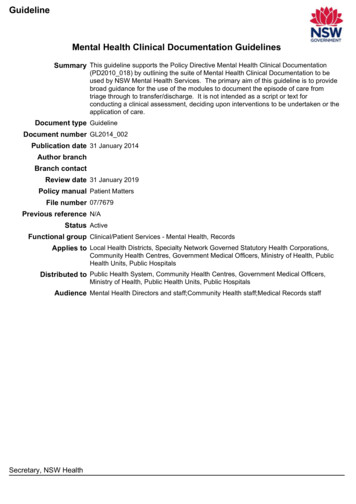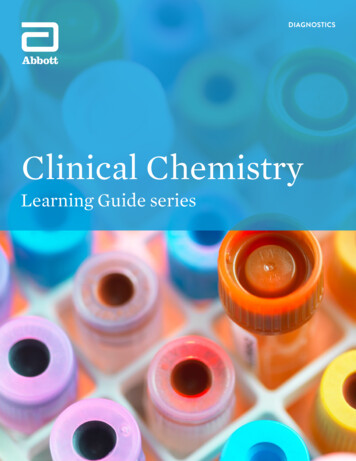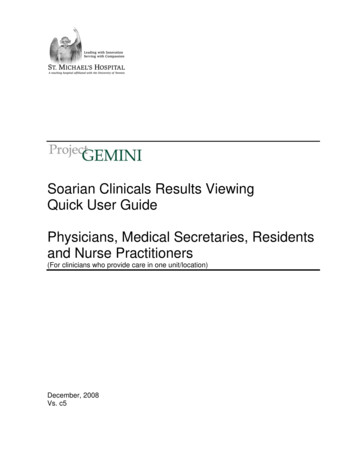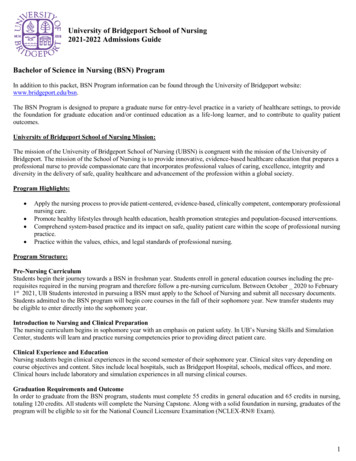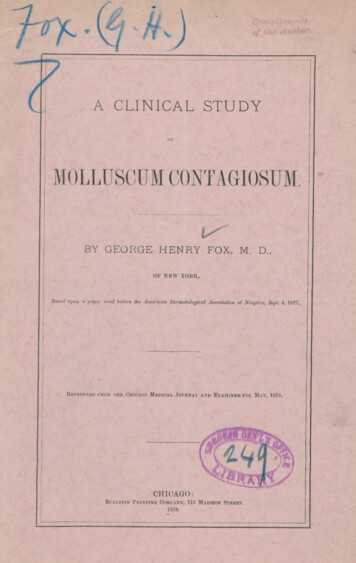
Transcription
A CLINICAL STUDYOFMOLLDSCUM CONTAGIOSUM.BY GEORGE HENRY FOX, M. D„OF NEWYORK.Based ttpou apaper rendReprinted frombeforetheAmerican Dermatological Association at Niagara, Sept. 4, 1877.the ChicagoMedical Journal and Examiner for May, 1878.CHICAGO:Bui,i, win Printing Company, 113 Madison Street.1878.
A CLINICAL STUDTOFMOLLUSCUM CONTAGIOSUM,By George HenryBased upona paper readFox, M. D., of New York.before the American Dermatological Association atNiagara, Sept. 4,1877.The little soft pea-sized tumors, with constricted base, centraldepressed orifice and whitish curdy contents, which constitute theaffection known as molluscura contagiosum, are so peculiar inappearance, that when once seen and recognized, they are not aptto be overlooked or mistaken when met with a second time. Itis probable, therefore, that the affection, though comparativelyrare, is familiar to every reader who has had much experience inthe treatment of children, or in the treatment of skin diseasesoccurring in the adult. For a description, I will refer to textbooks, and devote the space thus saved to a fuller discussion ofcertain interesting features of the affection. I have been exceptionally fortunate in having had cases come under my observation,thanks to the kindness of friends in the profession, and now inlooking over my notes, I find the following record of twenty-fivecases:I. A young woman. A single molluscum on forehead.11. A young woman. Face studded with mollusca, pretty evenly distributed. Eruption bearing a striking resemblance to that of the pustularstage of yariola.This case was decidedly unique, and my recollection of it isvivid. The patient was seen by two able physicians in NewYork, and although the diagnosis of variola was not actuallymade, it was strongly suggested to both, as the case occurredduring the extensive small-pox epidemic of 1874. Had thisr
2patient been placed in a small-pox ward, I think any physicianmight have walked by her bed without discovering at a glancethat it was not a genuine case of small-pox. The numerous,whitish, flattened tumors, with their central depression, bore amost striking resemblance, when observed from a short distance,to the urnbilicated pustules of variola, and as the girl’s face wasnaturally full and florid, the absence of redness and tumefactionwas hardly apparent.I If.Girl, eight years old. Two mollusca on right side of chin. Thinksliving in the same house, who hadthat she caught them from a little girlfive, likewise on the chin.IV. Lewis E., set. 13. Thin and pale,although in fair health. ExaminedFcl . 5, 1876. Two mollusca near right nipple, a small one on the nipple, asmall one over sternum, two on right arm, one on right shoulder, 26 onhack (18 of which were to the right of median line), and one on abdomen.The tumors were first noticed two weeks ago, and vary, from pin-head tosmall pea in size. No itching nor sensation of any kind, unless irritatedby contact of clothing. Feb. 19. A small molluscum noticed on dorsumpenis.This case was exhibited to the N. Y. Dermatological Society.It might be described as a general eruption of molluscum, similarto cases reported by Wilson, Zeissl, and Hutchinson.It is oneof the few cases I have met with, in which the mollusca were notconfined to a limited region of the body. These cases of generaleruption have been supposed to result in several instances, fromthe use of the Turkish bath. Whatever the probability of sucha cause may be, I must not omit to state that in ray case the boyhad suffered from scabies, and been subjected, without doubt, to anunusual amount of bathing. Several attempts at inoculation weremade in this case, both upon the patient’s body and upon myself.The expressed contents of the tumors were applied to scarifiedsurfaces, or rubbed into the sound skin, and in some instancescovered for a short time with a moist rag and bandage, but theattempts were without exception, unsuccessful. The tumors inthis case were of unusually rapid growth, and displayed atendency to speedy desiccation upon reaching the size of a pea.V. Joanna E., ast. 5. A red-cheeked, chubby little girl. ExaminedApril 8, 1876. Six or eight mollusca of varying size on left thigh, justabove popliteal space. Aff. c ion \eg in a year ago. During past week, agroup of the larger nes inflame I, and a dark crust formed. Apr 14.Noiiced two small mollusca on left gluteal region.
3In this case, as in others, there was no history whatever ofcontagion. Her little brothers and sisters, though playing withher by day and sleeping with her at night, had never beenaffected, nor had any of the neighbors’ children. One sister hadordinary warts on her hands.YI. Maggie C., set. 14. Pale, thin, and in poor health. Examined March24, 1876. A. pea-sized molluscum just above inner canthus of right eye.Another small one just below inner canthus of left eye, one on right side ofnose, and one on right side of chin. An eczema of both lids, with considerable thickening and marks where other mollusca have been. According to patient’s statement, a dozen or more pin-head sized mollusca appearedabout inner canthus of right eye, two months ago. An acute eczemaresulted from pinching these, and, shortly after, a conjunctivitis set in.This case, which was shown before the N. Y. Ophthalmologies!Society, illustrates an important clinical feature of the affection,viz., the tendency to severe conjunctivitis when the tumors arelocated upon the eyelids. Henderson, one of the early writersupon molluscum, relates a case in which the eye was destroyed.VIE. Wm. S., set. 1. Examined July 18, 1876. Twenty or more mollusca of varying size scattered over the face and neck, one on dorsum ofright index finger. First noticed three months ago. Have grown rapidlyduring past three weeks. The walls of several of the tumors exhibit amarked vascularity. The larger ones have assumed a dark red hue, andtend to ulcerate when scratched or picked. Mother has four other children,hut there is no evidence of contagion.Sept. 2d, 1876. Seven mollusca of varyingVIII. Annie M., set.size, two near the inner canthus of right eye, the others on chin, cheek, andneck. In May last had one beneath right oral commissure. A sister, set.7, had one at that time in a similar location, but no scar is seen at present.Two other children in the family are unaffected.IX. Kate M., set. 7. Examined Jan. 17, 1877. Small mollusca appearedeight months ago, on either side of chin and upon eyelids. Mother saysthe child used to play with another little girl, who had warts on her hands.Patient has now a small abscess over the outer canthus of left eye, also asmall ulceration at outer extremity of right eye-brow, both abscess andulcer showing where mollusca have undergone destructive inflammation,four mollusca on the chin, one surrounded by an inflamed areola, one highlyinflamed and swollen, another partly destroyed and covered by a scab. Aperfect one on the neck, and two small ones on wrist and thumb. A monthago, an older sister, aged 14, had four or five on left cheek, which disappearedsuddenly, and mother says, without scabbing.This case illustrates perfectly the tendency of molluscum todestructive inflammation, and the stages of this process.X.Annie K., aet. 12. A girl of strumous constitution.Examined May
47,1877. Has the remains of two or three mollusca on chin, existing eitheras an excoriation covered with a yellow crust, or as an indurated papule.They came only four weeks ago, but are already at too late a stage forrecognition as mollusca. States that she had three on side of nose, whichwere squeezed out. Her brother, aged 7, has a molluscum on forehead.Another brother and a sister are unaffected, although they sleep four in abed. A child of a married sister, who died last August at two years of age,had a number of mollusca around the eyes.XL Manfred H., set. 7. July 7, 1877. Has a single pea-sized molluscumon the tip of nose. It is of two months standing, and has enlarged withinpastweek. Patient states that a little brother had some around the eye about ayear ago, which disappeared suddenly, and that a little two year old babyhas now a few “specks,” size of pin-heads, under the eye.XII. Fannie W., set. 1%. Examined July 7, 1877. Nearly one hundredmullusca beneath chin, varying in size. A bean sized tumor is caused bythe close proximity of several. There are a few scattered on neck andbreast, and about the eyes. An older sister has nothing of the kind. Shelives next door to Annie M. (Case YIII.)XIII. Mary Agnes R, set. 10. A weak strumous child. ExaminedJuly 9, 1877. Two ulcerating mollusca upon neck, small ones on chin. Ared spot on breast where one came 6 months ago, and disappeared byulceration a month ago. Has four warts on the left hand.XIV. Mary T., set. 8. Ten or twelve mollusca on chin in differentstages of development and decline. Several are minute, two are typical,and two consist merely of blackish scabs upon an inflamed base. According to the mother, her three brothers are unaffected, and no children residing in the same house have had anything like it. Before the mollusca madetheir appearance six months ago, the child had seven warts on right middlefinger. Whether these were mollusca or ordinary warts, the mother cannot positively say.XV. Edward C., a3t. 6 months. Ten mollusca on right temple, tw o ofwhich have coalesced, five on scalp, one on left ear, two on left temple, oneon shoulder, one on left hand, all of two mouths standing. A brother whodied a year ago, had the same. A little girl in the same house has onethathas recently come on forehead, but four of Mrs. C’s children are free.XVI. Ellen McK., set. 7 months. Two mollusca upon scalp, one onthe ear and two near eye. There are eight families living in the samehouse, with a full quota of children, but no history of contagion. Themother has warts on her hands, and says she has always had warts since argirl.XVII. Joanna H., aet. 21 months. A pale and sickly infant. Threemollusca on chin, and marks of three more which have existed beneath thechin, two near right eye. Has had them four or five months. Those whichdisappeared became of a dark red hue and withered. The child has a warton its finger. Three other children in thefamily are unaffected. One ofthem however, has warts on the hand.XVIII. Jessie McD., a3t. 2. A tat and red cheeked child. Five smallmollusca around the mouth. An inflamed one, of pea size, onleft side of
5bridge of nose. These were noticed fourmonths ago. About a year agothe child had a wart on fore-finger, of which a red cicatrix remains. Mother,thinks it was an ordinary wart, and not like the mollusca now on face. Xohistory of contagion.-In the cases thus far given, the mollusca have been found tooccur mostly upon the face. In the remainder of my cases it will he noticed that the eruption occurred solely upon the genitals. Molluscous tumors of this region have been regarded bysome as differing from those upon the face and elsewhere, andthe term condyloma subcutaneum has been applied to them.There is, however, no ground for any such distinctive name, asthe molluscous tumors, wherever occurring, are identical inanatomical structure and external appearance. To be sure thegenital tumors occur mostly in adult life, while the facial tumorsare usually met with in infancy and childhood, but that molluscamay occur on the adult face, is shown by Cases I. and 11., whileCase IY. proves that it is not impossible to find the affection upona juvenile penis. Though regarding these mollusca as identicalin nature, irrespective of location, it will be found convenient inarriving at statistics relative to sex, age, etc., to separate theminto two clinical classes, as follows A, molluscum affecting theface and body, and commonly occurring among children. B,molluscum of the adult genitals.:XIX. An Italian patient in the Yen. Dept, of the Xew York Disp., withabout fifty mollusca upon anterior half of penis. Two at the peno-scrotaljunction. They were of two years standing, and easily destroyed byincision and cautery.XX. Another Italian, with gonorrhoea. Two large mollusca of one year’sstanding, had coalesced on right side of sheath of penis, over the corona,on right thigh was another molluscum, corresponding in situation to theformer, when the congested penis was placed parallel with the thigh. Thisposition of the mollusca suggested the idea of auto-inoculation, such as isoccasionally observed in case of chancroid.XXI. Gustavus 8., set. 18. Examined September 14,1876, when patientapplied with gonorrhoea, venereal warts, and a papular syphiloderm. Threemonths previously, and before any of these troubles began, he noticed fivemollusca on the posterior half of the dorsum penis, which still remainedunchanged. Six months previously, some large, so-called, “seed warts,”came upon the back of his right hand.XXII. Edw. D., set. 31. February 5, 1877, patient applied for treatmentof a stricture. About 10 small mollusca were situated upon penis and edgeof mons veneris, varying in size from a pin’s head to a grape seed. First
6noticed them two months ago, since which time they have steadily increasedjn size. They itch a little, and once he made one bleed.XXIII. J. L., set. 24. Patient with chancroid and gonorrhoea. Has hadfour or five mollusca on penis during past year. A small one now ondorsum, which came four or five weeks ago. One on right thigh near baseof penis. Had warts on hands a year ago.XXIY. Wm. S., set. 20. August 18, 1877. A small molluscum on dorsum penis over the glans. Says he pinched a large one off last week whichhad existed for several mouths. A wart on right little finger. Has had ahalf dozen or more within as many years. A few moles on body. Anepithelioma was removed from the left side glans penis by Dr. F. X. Otis, atthe Coll, of Phys. and Surg., last May. At the point where an inoculationwas made upon the right breast, there is now a small, oval, reddish, hardlump, suggestive of incipient keloid.XXV. Juo. G., mt. 22, October 19, 1877. A small molluscum on rightthigh opposite scrotum. Came a few weeks ago after some moist papuleson scrotum and penis. A small wart on thumb lias existed over a year.Formerly had larger ones.As to frequency of occurrence, molluscum may be said to be arare affection. Those having charge of juvenile asylums orclinics for diseases of children, are far more likely to meet withcases than those who treat skin diseases in institutions mostlyattended by adults.According to statistical tables prepared by White, the affectionoccurs about once in every thousand cases of skin disease,whether in dispensary or in private practice. And yet the affection is without doubt far more common among the poorer classesthan it is among the well fed and cleanly patients met with inprivate practice. This seeming paradox is made clear when wereflect that among the wealthy, every case of molluscum is presumably seen by the physician, while among the poor, a large precentage of cases are only driven to the dispensaries when thetumors become a source of discomfort or excite apprehensions ofdanger in the minds of the parents.While one case is found among a thousand patients, old andyoung, who apply at a clinic for skin diseases, a much largernumber will doubtless be found among a thousand children whoapply at a clinic for children’s diseases, especially if the affectionis sought for, and not merely noted when complaint is made. Asto the relative frequency of genital molluscum, it may be said tooccur also in the ratio of one in a thousand. At least, the seven
7cases reported above, were the only ones observed in as manythousand men whose genitals I have had occasion to examine inthe male venereal department of the New York Dispensary. Innone of these six cases did the patient apply for relief onaccount of the mollusca, these being treated incidentally, and inno case did I succeed in eliciting any history of contagion. Asis well known, the affection occurs likewise upon the female genitals, and, for all I know to the contrary, with about an equalfrequency.Confining our attention now to the eighteen cases constitutingthe first group, we notice that five were infants, eight betweenthe ages of three and ten, while five were older. As to sex, fourteen of the eighteen were females. This accords with a statement which has been made that the affection is more commonamong girls. In sixteen of the cases, the face was affected eitheralone or in connection with neighboring parts. The boy (CaseIV.) had mollusca on body and on penis, but none on the face.The girl (Case V.) had mollusca only on the thigh.Occurring upon the face, the tumors exhibited in many instances a tendency to congregate about the eyes, and occasionallyabout the mouth. The chin and neck were far more frequentlyaffected than the cheeks or forehead. In a few of the cases thetumors were exceptionally located upon the ears, scalp and tip ofnose.There is one point connected with these cases of molluscum, towhich I wish now to call attention, and that is the relation whichthis affection may possibly bear to ordinary warts.In examining some of the more recent cases I was struck bythe frequent co-existence of warts upon the hands of the patient orupon some member of the family.This lat first regardedas an insignificant coincidence. Later, in reviewing for the firsttime the notes of my cases, I was again struck by the numerousreferences to the co-existence of warts. In eight of the twentyfive cases, I find that I have noted the presence or past occurrenceof warts upon the hands of the patient, while in four other casesmention is made of some playmate or member of the family beingaffected.Had my notes of these cases been full instead of brief, or had
8I examined patients with reference to this point, I think it probable that I should have noted the existence of warts in many morecases. Certainly in the few cases which I have examined sincethe idea of looking for warts occurred to me, I have not failed tofind them in a single case. My friend Dr. Morrow, who hasexamined a number of molluscous children, tells me that he hasnoted warts on the hands in over three-fourths of the cases. Ofcourse, warts are very common upon the hands of both youngand old, and there is no reason why they should not co-existwith any skin affection. Nevertheless, in the cases I havereported, the co-existence of warts with molluscum would seemtoo frequent to be accidental, and I trust that any reader whomay have an opportunity of examining many cases of molluscumwill not neglect to note the existence or the non-existence ofordinary warts.The etiology of molluscum, in spite of all that has been written, remains obscure. Although it occurs with much greaterfrequency among the poorer classes, it can not be considered asthe offspring of poverty and uncleanliness. Damp and crowdeddwellings may favor its development, as I have known a numberof cases to occur in the same locality, and found by examinationthat direct contagion was not a probable cause. 11l health,though it may invite the morbid growth, is not always a factor inits production, for while most of the children I have seen iverestrumous or weakly, there were some upon whose faces not eventhe dirt could conceal the glow of health.To explain the unexpected appearance of mollusca, verrucee,[Note.—With a view to determining the percentage of children who are afflicted with warts,my friends Dr. 10. P. Williams and Dr. W. S. Conover, both of whom have charge of children’sclinics at the New York Dispensary, were kind enough to examine for me 200 of their littlepatients, and the result proved that 30 out of the 200, or 15 per cent., were affected with wartsDr. Conover examined 50 boys and 50 girls, ranging from 2 to 13 years of age; 8 girls wereaffected and 5 boys, and one little girl, who had mollusca upon the face showed the remains of awart upon the finger. (See Case XVIII.) None of the 100 children had had warts previouslyaccording to statements of mothers, and of 4 cases where warts were reported as affecting othermembers of the family, 3 are included in the 13, showingperhaps a family tendency Dr. Williams also examined 50 boys and 50 girls of a similar age, and found that 13 boys were affectedand only 4 girls. One of the boys who presented 16 warts belonged to a family in which 6 othermembers were reported either to have or to have had warts. Of the 83 cases not affected, 19 arereported to have had warts previously. In an examination of over 200 adult males in thevenereal department, I found that 23 per cent, were affected with more or less m rked papillarygrowths upon the hands, while a number of others presented slight callosities, which upon dirtbegrimed digits are often difficult to distinguish from warts.]
9and other innocent excrescences, we must admit on the one hand,an idiosyncracy or diathesis on the part of those affected, oron the other hand, a contagious principle.The contagiousness of molluscum has long been the subject ofdiscussion, and as yet the question is by no means settled. Letus now examine the data upon which any decision of the question must be based. Bateman’s first case (1817) was a youngwoman whose face and neck were thickly studded with mollusca.She ascribed the origin of this disease to contact with the faceof a child whom she nursed, on which a large tubercle of thesame sort existed.” Two other children and a servant of thefamily were likewise affected. Upon these facts Bateman assumeda contagious element, and embodied the assumption in the namemolluscum contagiosum. Caillault reports that a child wasattacked by molluscum in one of the wards of the Hdpital desEnfants at Paris, and within three months, 14 of the 30 littlegirls in the ward were likewise affected. These facts, and othersimilar ones to which we all can testify, support an hypothesisthat the affection is contagious, but they furnish no conclusiveproof. In many instances of the affection, we find neither evidence nor even hint of a contagious nature. It seems to have aspontaneous origin in a given case, and the children who playwith, sleep with, and wear the clothes of the patient, remainfree.There may, indeed, be a parasite or other contagiouselement, but has its existence been demonstrated? No. Thesimultaneous or successive occurrence of several cases in a hospital ward, a tenement house, or a single family, though possiblydue to contagion, may be explained upon other grounds. Thestrongest argument, however, in favor of a contagious nature,rests upon the statement of Iletzius, who claims to have inoculated the growth upon his own person. Many others, it is true,have tried this, and failed, but no argument can be based uponsuch negative results. Here then, the case rests, and until theinoculation by Betzius has been repeatedly verified, or until aparasite or germ of some kind has been demonstrated, or untilsome further facts have come to light, we can not say positivelythat molluscum is or is not contagious.If contagious, the affection can not, as far as degree is con“
10cerned, be ranked in the category with scabies and ringworm. Itseems to me, in this respect, to warrant a comparison with verruca. Ido not know what the opinion of my readers may be, asto the contagiousness of ordinary warts. Many people certainlybelieve them to be “catching,” and children, when afflicted, willoften point out the very boy from whom they allege to havecaught them. The text book writers pass lightly over, or aresilent on this point. Tilbury Fox says, in speaking of warts ingeneral, they appear sometimes to be contagious.” The sameremark might be applied to mollusca, which appear sometimesto be contagious.” There are other points of resemblance in theclinical aspect of molluscum and verruca, which may have morethan a fanciful interest. They are both apparently of local origin,and attack both the robust and the weak. They are alike in theiruncertain etiology, and their indefinite duration, and finally theypossess in common, that strange peculiarity of suddenly disappearing from no apparent cause. Considering then, these points ofresemblance, and the frequent co-existence of the two affections,it seems to me, as I have already remarked, that the relationbetween molluscum and verruca is a subject worthy of investiga““tion.
THE CHICAGOMedical Journal &, Examiner(established 1844.)EDITORSWILLIAM 11. BYFORD., A. M., M. D.,JAS. NEYINB HYDE, A. M., M. D.,FEUD. 0. HOTZ, M. D.E. FLETCHER INGALS, 31. D.ISSUED MONTHLY.Two Volumes a year of 672 pages each ; beginning with theJanuary and July Numbers:The first number of the Illinois and Indiana Medical and Surgical Journalwas issued in 1844, with the late Prof. Jas. V. Z. Blauey as editor. The nameof the Journal was changed four years later to the Northwestern Medical andSurgical Journal, and in 1858 it was again changed to THE CHICAGO MEDICALJOURNAL, under which title the Journal was published for seventeen years,when the present name was adopted, on account of the incorporation with it ofthe Chicago Medical Examiner.Th.o Svledical Press AssociationNow publishes this Journal for the benefit of theCHICAGO MEDICALLIBRARY.This is one of the largest and best medical journals in the country. It furnishes more reading matter for the money than any other journal in the UnitedStates, with one exception, and its excellence is attested by the fact that it istaken by nearly all the leading men in the West.Terms —54.00 per annum in advance. Single Copies, 35 cents.Free. Subscriptions received for any period. Address,E. FLETCHER INGALS,M.Postage! .188 CLARK STItEKT, (HMlAtiO.The Chicago Medical Journal and Examiner and the Journal of Nervousand Mental Diseases, 7.50 per annum.THEJournal of Nervous and Mental DiseaseIs a quarterly, edited by Prof. J. S. Jewell, M. D., and IT. M. Bannister, M. D. ; AssociateEditors. W. A. Hammond, M. D., New York ; S. Weir Mitchell, M. D., Philadelphia; andK. H. Clarke, M. D., Boston. IPrice, 5.00 a, year.The Chicago Medical Journal and Examiner and the Journal ofand Mental Disease, 557.50 per annum.NervousWe can furnish other journals at a liberal discount.Send Subscriptions and Communications toE. FLETCHER INGALS, M. D.,188Clark Street, Chicago.
Thinand pale,although in fairhealth. Examined Fcl . 5, 1876. Twomolluscanearrightnipple,asmall one onthe nipple, a small one oversternum,two on right arm, one on right shoulder, 26 on hack (18of which wereto theright ofmedianline), and one on abdomen. The tumors were first noticed t
